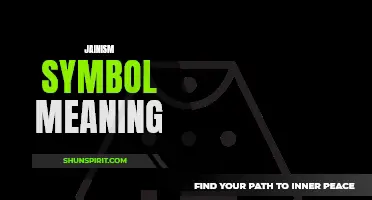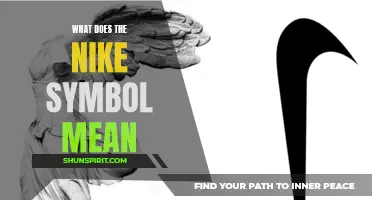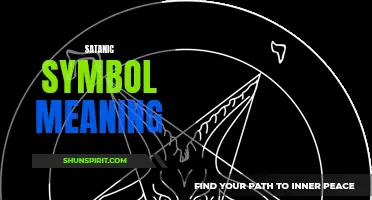
The raised fist symbol has long been recognized as a powerful and impactful image, representing unity, strength, and solidarity. From political movements to social justice campaigns, the raised fist has become a universal symbol of resistance against oppression. It has transcended borders, cultures, and ideologies, serving as a visual reminder of the collective power of the people's voice. In this article, we will delve into the historical and cultural significance of the raised fist symbol and explore its various interpretations throughout history.
What You'll Learn
- What is the historical origin and significance of the raised fist symbol?
- How has the raised fist symbol been used in various social and political movements throughout history?
- What is the meaning of the raised fist symbol in the context of contemporary activism?
- How does the raised fist symbol relate to ideas of unity, solidarity, and resistance?
- Can the raised fist symbol have different interpretations or meanings in different cultural or regional contexts?

What is the historical origin and significance of the raised fist symbol?
The raised fist symbol is a powerful and widely recognized symbol of solidarity, strength, and resistance. It has a rich and historical origin that can be traced back to various social justice movements throughout history.
The use of the raised fist as a symbol can be traced back to the early 20th century, particularly in the labor movement. The fist represents unity and collective action, as it symbolizes a group of individuals coming together in a show of strength and solidarity.
One of the earliest uses of the raised fist symbol can be found in the Industrial Workers of the World (IWW) movement in the early 1900s. The IWW, also known as the "Wobblies," were a radical labor union that fought for better working conditions and fair wages for all workers. They popularized the use of the raised fist as a symbol of resistance against the oppressive capitalist system.
The raised fist symbol gained further prominence during the civil rights movement in the 1960s. It was adopted by the Black Power movement as a sign of black pride, strength, and resistance against racial discrimination. The iconic image of Tommie Smith and John Carlos raising their fists in a black power salute during the 1968 Olympics further solidified the raised fist symbol as a powerful and resonant image of protest and defiance.
In subsequent years, the raised fist symbol has been adopted by various social justice movements around the world. It has been used by feminists, LGBTQ+ activists, anti-apartheid activists, anti-war demonstrators, and many others. The symbol serves as a rallying cry for these movements, uniting people under a common cause and amplifying their message of resistance and solidarity.
The raised fist symbol has also gained significant traction within popular culture. It has been widely used in political posters, artwork, and merchandise. It has also been referenced in music, literature, and film. The symbol has become an enduring and recognizable emblem of protest and resistance, transcending its initial historical context.
The historical origin and significance of the raised fist symbol lie in its ability to represent the collective strength and determination of marginalized and oppressed groups. It serves as a visual reminder that unity and solidarity are powerful tools for bringing about social change. By raising their fists, individuals and communities can signal their resistance against injustice and their commitment to fighting for a more equitable world.
The Symbolic Meaning of Algiz: A Guide to Understanding its Significance
You may want to see also

How has the raised fist symbol been used in various social and political movements throughout history?
The raised fist symbol has been used as a powerful and iconic image in various social and political movements throughout history. It is a gesture that represents unity, strength, and resistance against oppression. This symbol has been used by different groups to protest against racism, inequality, and injustice.
One of the earliest known uses of the raised fist symbol was in the late 19th century by the Industrial Workers of the World (IWW). The IWW used the symbol during labor strikes and protests to symbolize solidarity among workers and their fight for better working conditions. The raised fist represented their determination and strength in standing up against exploitation by capitalist bosses.
In the 1960s and 1970s, the raised fist became closely associated with the Civil Rights Movement and the Black Power Movement. Civil rights activists such as Martin Luther King Jr. and Malcolm X used the symbol to represent the struggle for racial equality and justice. The raised fist was a powerful visual statement of black power, self-determination, and resistance against systemic racism. It became a symbol of pride and empowerment for African Americans during this time.
The raised fist symbol was also widely used by the feminist movement in the 1970s. Women's rights activists adopted the symbol to represent their fight for gender equality and liberation. The raised fist conveyed strength and solidarity among women, as well as a rejection of traditional gender roles and patriarchal oppression. It became a powerful symbol of women's empowerment and resistance against sexism.
In recent years, the raised fist symbol has been used by various social and political movements. It has been a common sight at protests against police brutality and racial injustice, particularly in the Black Lives Matter movement. The symbol represents the ongoing struggle for racial equality and justice, as well as a call for an end to systemic racism.
Additionally, the raised fist has been used in protests for LGBTQ+ rights, environmental activism, and other social justice causes. It has become a universal symbol of resistance against all forms of oppression and a way to show solidarity with marginalized communities.
Overall, the raised fist symbol has played a significant role in various social and political movements throughout history. It has served as a visual representation of unity, strength, and resistance against oppression. By using the raised fist, these movements have been able to communicate their messages of solidarity and defiance, inspiring others to join their cause.
Unveiling the Hidden Meanings Behind Roman Symbols and Their Significance
You may want to see also

What is the meaning of the raised fist symbol in the context of contemporary activism?
The raised fist symbol has a long history in activism and has been used as a powerful representation of solidarity, strength, and resistance. In the context of contemporary activism, the raised fist symbol is often associated with movements fighting for social justice, equality, and human rights.
The raised fist symbol is believed to originate from the clenched fist symbol used by labor unions and workers' movements in the late 19th and early 20th centuries. It was a visual representation of workers' unity and their determination to fight for their rights against exploitation and oppression.
In the 1960s, the Black Power movement in the United States popularized the raised fist symbol as a symbol of resistance against racial discrimination, police brutality, and systemic oppression. This movement, led by civil rights activists like Malcolm X and the Black Panther Party, used the raised fist to assert black pride, identity, and solidarity. The symbol became a powerful image of defiance and a call for change.
Since then, the raised fist symbol has been adopted by various social and political movements around the world. It has become a universal symbol of resistance and struggle. Activists fighting for women's rights, LGBTQ+ rights, indigenous rights, environmental justice, and many other causes have embraced the symbol to express unity and strength in their struggle for justice.
The raised fist symbol has also been closely associated with the global protest movements of the early 21st century, such as the Occupy Wall Street movement and the Arab Spring. These movements, fueled by a sense of economic inequality, political corruption, and social injustice, used the raised fist to symbolize their demand for a more equitable and democratic society.
In recent years, the raised fist symbol has gained renewed prominence with the rise of the Black Lives Matter movement. This movement, sparked by the killings of African Americans by police officers, has brought issues of racial injustice and police brutality to the forefront of public consciousness. The raised fist has been a prominent symbol at protests and rallies, serving as a rallying cry for justice and an expression of solidarity with the victims of systemic racism.
The meaning of the raised fist symbol in the context of contemporary activism goes beyond its historical origins. It stands as a powerful reminder of the ongoing struggles for social justice and equality. It embodies the collective strength and determination to challenge oppressive systems and fight for a more just and inclusive world. The raised fist symbol serves as an invitation for individuals to join the movement and actively participate in the ongoing struggle for a better future. As long as there are injustices to fight, the raised fist will continue to be a potent symbol of resistance and hope.
Exploring the Symbolic Chart: Decoding the Meaning of Evil Eye Colors
You may want to see also

How does the raised fist symbol relate to ideas of unity, solidarity, and resistance?
The raised fist symbol has long been associated with ideas of unity, solidarity, and resistance. Used as a powerful visual motif, this symbol has become iconic in various social and political movements throughout history.
One of the earliest known instances of the raised fist symbol can be traced back to the 1917 Russian Revolution, where it was used as a symbol of workers' solidarity and defiance against the Tsarist regime. The symbol was adopted by the Bolsheviks and became closely associated with the Communist Party and Marxist ideology.
In the mid-20th century, the raised fist symbol gained renewed prominence during the Civil Rights Movement in the United States. African American activists, such as Martin Luther King Jr. and Malcolm X, utilized the symbol to represent their struggle against racial inequality and for justice. The raised fist served as a unifying symbol, signaling a collective determination to fight for equality and to resist systemic oppression.
Similarly, during the 1960s and 1970s, the raised fist symbol became synonymous with the global student and anti-war movements. In protests against the Vietnam War and for various social justice causes, activists raised their fists as a show of unity and resistance against what they perceived as unjust government policies.
In the 1980s and 1990s, the raised fist symbol was adopted by various other social and political movements. Feminist activists used it as a symbol of women's empowerment and the fight against gender inequality. LGBTQ+ activists incorporated the raised fist into their protests, representing their struggle for equal rights, visibility, and acceptance.
In recent years, the raised fist symbol has gained renewed significance in response to a range of social justice issues. It has been prominently displayed during protests against police brutality and systemic racism, symbolizing solidarity with the Black Lives Matter movement. The symbol has also been used in rallies advocating for immigrant rights, environmental activism, and workers' rights.
The power of the raised fist symbol lies in its ability to convey a sense of unity, solidarity, and resistance. It represents the collective strength and determination of individuals coming together to challenge injustice and fight for a better world. It serves as a reminder that no matter the cause or the struggle, there is power in unity and resistance, and that change is possible when people join forces.
The Hidden Meanings Behind GDT Symbols Revealed
You may want to see also

Can the raised fist symbol have different interpretations or meanings in different cultural or regional contexts?
The raised fist symbol is recognized and used worldwide as a sign of solidarity, resistance, and unity. It has played a significant role in various social and political movements across different cultural and regional contexts. However, like any symbol, its interpretation and meaning can vary depending on the cultural and regional context in which it is used.
The raised fist symbol, often accompanied by the phrase "power to the people," first gained popularity during the Civil Rights Movement in the United States in the 1960s. It was used as a symbol of black power and solidarity among African Americans fighting against racial discrimination and injustice. The iconic image of Tommie Smith and John Carlos raising their fists during the 1968 Olympics has become one of the most recognizable symbols of protest and resistance.
In Latin American countries, the raised fist symbol has been associated with leftist political movements and socialist ideologies. It has been used by labor unions, student organizations, and revolutionary groups to express their demands for social justice and equality. The symbol has been used throughout history during various uprisings and revolutions, such as the Cuban Revolution and the Sandinista Revolution in Nicaragua.
In many African countries, the raised fist symbol represents a collective struggle against colonialism and oppression. It has been used by anti-colonial and independence movements to rally support and convey the message of resistance against foreign rule. The symbol has been embraced by leaders and freedom fighters such as Nelson Mandela and Robert Mugabe, who fought for the liberation of their respective nations.
In some Asian cultures, the raised fist symbol carries a different meaning. In China, for example, the raised fist is often associated with the Chinese Communist Party and is used as a symbol of solidarity and loyalty to the party's values and ideologies. In Japan, the raised fist symbolizes a call to action or unity in various contexts, such as labor movements and student protests.
However, it is important to note that the raised fist symbol is not solely tied to political movements or resistance struggles. In some cultures, it can also be used as a symbol of celebration, strength, or victory. For example, in many African and Caribbean countries, the raised fist is associated with traditional dance and music, symbolizing joy and unity within the community.
In conclusion, the raised fist symbol can indeed have different interpretations and meanings in different cultural and regional contexts. It represents a rich history of resistance, solidarity, and unity in various social and political movements worldwide. While its core message of empowerment and justice remains consistent, the symbol's specific connotations can vary based on the historical, cultural, and regional contexts in which it is used.
The Symbolic Meaning of Robins: Messages from the Natural World
You may want to see also
Frequently asked questions
What does the raised fist symbol mean?
The raised fist symbol is often associated with power, solidarity, and resistance. It has been used as a symbol of unity and strength in various social justice movements, including civil rights, labor rights, and Black liberation movements. The symbol represents the collective struggle for justice and equality.
The raised fist symbol has a rich history and can be traced back to different cultures and time periods. One of the earliest appearances of the raised fist as a symbol of resistance can be found in the labor movement of the early 20th century. It gained significant visibility and recognition during the civil rights and Black Power movements of the 1960s. The symbol has since been adopted by many other social justice movements around the world.
While the raised fist symbol is often associated with political activism and social justice causes, it can also be used in other contexts. The symbol has been used to represent strength, solidarity, and resistance in various forms of art and popular culture. Additionally, some individuals may use the raised fist as a personal symbol to express their own beliefs and values.
The raised fist symbol has evolved and adapted to different contexts throughout history. In the 1960s, for example, the Black Power movement brought prominence to the raised fist as a symbol of Black liberation and empowerment. Since then, the symbol has been used in various movements, each adding their own nuances and meanings. The symbol continues to evolve and be used as a powerful visual representation of resilience and collective action.







